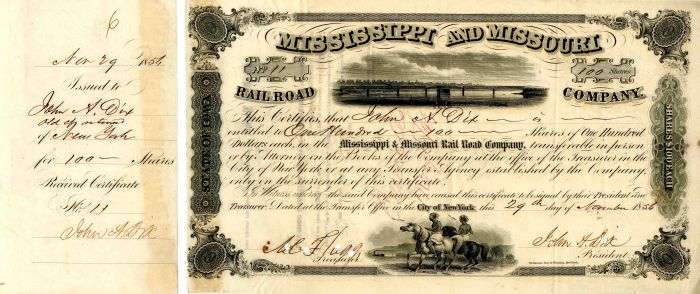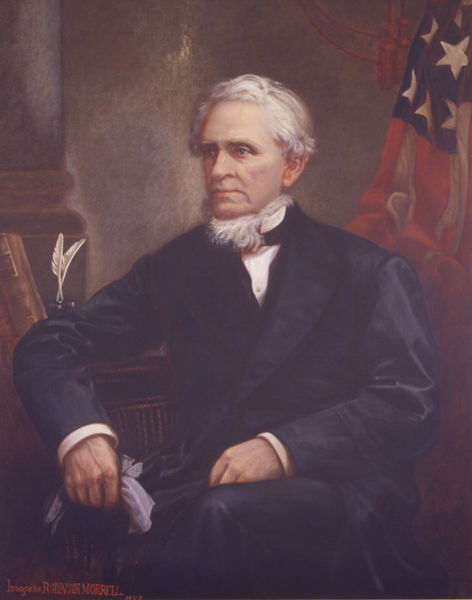General John A. Dix - Mississippi and Missouri Railroad Co. - Stock Certificate
Inv# AG1214A Stock
Missouri
Stock issued to and signed on stub and as president by John A. Dix. Nice! Very slight hole cancel at signature.

General John A. Dix (1798-1879) Dix was born in Boscawen, NH and joined the Artillery as a military cadet at the age of 14. He served in the US Army and attained the rank of captain.
In 1826, Dix married Catherine Morgan, the adopted daughter of Congressman John J. Morgan, who gave Dix a job overseeing his upstate New York land holdings in Cooperstown. Dix and his wife moved to Cooperstown in 1828, and he practiced law in addition to overseeing the land holdings. He was appointed Adjutant General of New York State by Governor Throop. He moved to Albany, New York in 1830, and served as Secretary of State of New York from 1833 to 1839.
Dix was elected as a Democrat to the United States Senate to fill the vacancy caused by the resignation of Silas Wright, Jr., and served from 1845 to 1849. He was not a candidate for reelection, having become a candidate for Governor. He was an unsuccessful Free-Soil candidate for Governor in 1848 losing to Hamilton Fish.
In 1853 Dix was president of the Mississippi and Missouri Railroad. He was appointed postmaster of the City of New York and served from 1860 to 1861. In addition to his military and public duties, he was the president of the Union Pacific from 1863 to 1868 during construction of the First Transcontinental Railroad. Dix was the figurehead for rail baron Thomas C. Durant, in both of his railroad presidencies.
He was appointed United States Secretary of the Treasury by President James Buchanan in 1861. At the outbreak of the Civil War, he sent a telegram to the Treasury agents in New Orleans ordering that: "If any one attempts to haul down the American flag, shoot him on the spot." Although the telegram was intercepted by Confederates, and was never delivered to the Treasury agents, the text found its way to the press, and Dix became one of the first heroes of the North during the Civil War. At the start of the American Civil War, Dix was appointed a major general in the New York Militia.
He served as the temporary chairman of the 1866 National Union Convention, was the United States Minister to France from 1866 to 1869, and served as the Governor of New York in his seventies as one of the oldest governors of New York. Dix died in New York City and was interred in the Trinity Church Cemetery.
The Mississippi and Missouri Railroad (M&M Railroad) was the first railroad in Iowa and was chartered in 1853 to build a line between Davenport, Iowa, on the Mississippi River and Council Bluffs, Iowa, on the Missouri River and played an important role in the construction of the First Transcontinental Railroad.
The line was originally created so that the Chicago and Rock Island Railroad could extend its line across the Mississippi River via Government Bridge, the first bridge to cross the Mississippi.
Shortly after the bridge opened in 1856, a steamboat hit the bridge and steamboat companies sued to have the bridge dismantled. The M&M and Rock Island hired private attorney Abraham Lincoln to defend the bridge. The case was to work its way through the courts to reach U.S. Supreme Court in 1862 during the American Civil War when the court decided in the bridge's favor.
During Lincoln's investigation into the case ,he traveled to Council Bluffs to inspect M&M property in August 1859 under the guidance of the M&M attorney Norman Judd. On the visit Judd and M&M engineer Grenville Dodge described the merits of locating the eastern terminus of the railroad at Council Bluffs. After the Pacific Railroad Act in 1862, Lincoln selected Council Bluffs as the eastern terminus and the Union Pacific created by former M&M owner Thomas C. Durant as the company to build the railroad road eastward.
Durant was slow to build the M&M through Iowa although quick to manipulate its stock. He had gained control of the Union Pacific because of his stated plans for the M&M. However, the line under his ownership did not even make it half way across the state, terminating in Kellogg, Iowa, 40 miles (64 km) east of Des Moines, Iowa, in 1865 with a branch to Muscatine, Iowa, ending in Washington, Iowa.
Durant built up his fortune by manipulating the M&M stock via rumors. First he drove up M&M stock by saying the transcontinental railroad would travel across Iowa via the M&M while at the same time quietly buying depressed Cedar Rapids and Missouri Railroad (CR&M) stock. Then he spread rumors that drove up the CR&M stock that the transcontinental would follow that line instead and Durant bought back the newly depressed M&M stock. The gambit made Durant and his cohorts $5 million.
The Rock Island Line bought the M&M on July 9, 1866, and completed its line to Council Bluffs in 1869 and extended the Muscatine/Washington Line to Leavenworth, Kansas. The merged railroad was called the Chicago, Rock Island and Pacific Railroad, a name it kept until it was dissolved in bankruptcy in the 1970s.
A stock certificate is issued by businesses, usually companies. A stock is part of the permanent finance of a business. Normally, they are never repaid, and the investor can recover his/her money only by selling to another investor. Most stocks, or also called shares, earn dividends, at the business's discretion, depending on how well it has traded. A stockholder or shareholder is a part-owner of the business that issued the stock certificates.










Ebay ID: labarre_galleries